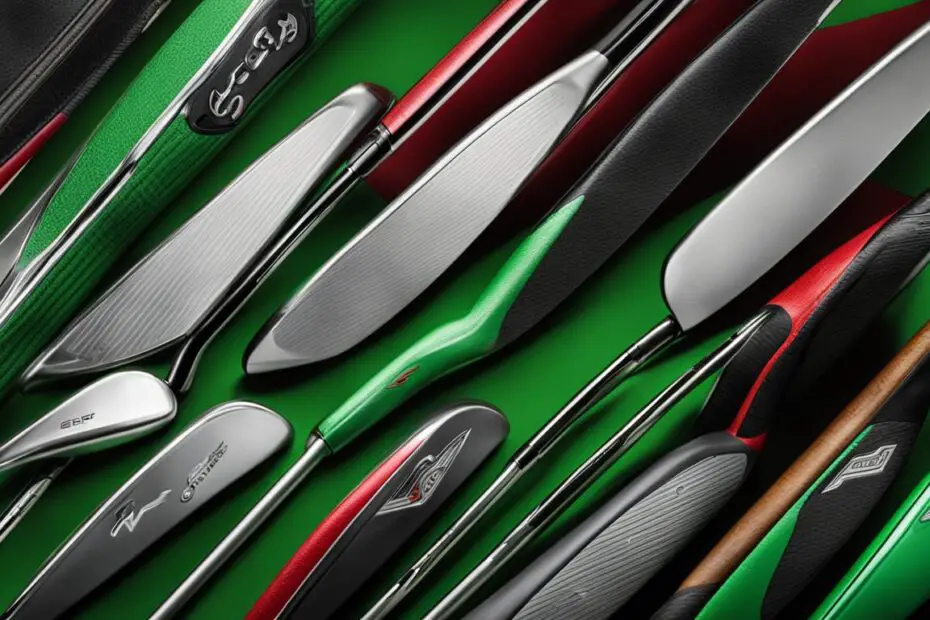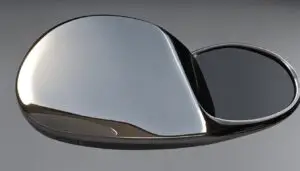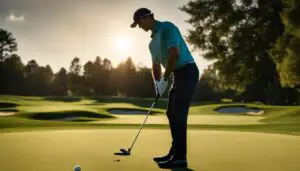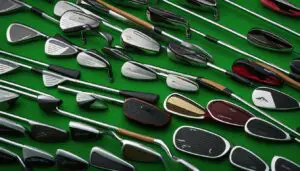A golf club is a tool used to strike a golf ball in the game of golf. It consists of three main components: the head, the shaft, and the grip. The head is the part of the club that comes into contact with the ball and determines the type of shot the club is designed for. The shaft connects the head to the grip and influences the club’s flexibility and power. The grip is where the golfer holds the club, providing control and comfort.
Golf clubs are vital for playing the game of golf, as each type of club is designed for specific shots and distances on the golf course. Understanding the different types of clubs and their components can enhance a golfer’s performance and enjoyment of the game.
Key Takeaways:
- A golf club is a tool used to strike a golf ball in the game of golf.
- It consists of three main components: the head, the shaft, and the grip.
- There are various types of golf clubs, including woods, irons, hybrids, wedges, and putters.
- Each type of club is designed for specific shots and distances on the golf course.
- Understanding the different types of golf clubs can help golfers make informed decisions when selecting clubs for their game.
Basics of Golf Clubs
A golf club consists of three main components: the head, the shaft, and the grip. Each component plays a critical role in determining the performance and feel of the club.
The head is the part of the club that comes into contact with the golf ball. It is responsible for shaping the shot and determining the type of shot the club is designed for. Different types of club heads are available, such as drivers, fairway woods, irons, hybrids, wedges, and putters. Each type of club head is designed to optimize performance for specific shots on the golf course.
The shaft connects the head to the grip of the golf club. It plays a crucial role in the club’s overall flexibility and power. Shafts can vary in length, material, and flexibility. Longer shafts generally provide more distance, while shorter shafts offer more control. The material of the shaft, such as steel or graphite, also affects the club’s performance and feel.
The grip is where the golfer holds the club. It provides control, comfort, and stability during the swing. Golf club grips are typically made of rubber or leather materials. The size and texture of the grip can vary to suit individual preferences and playing styles.
Understanding the components of a golf club is essential for selecting the right clubs for your game. Each component contributes to the overall performance and feel of the club, allowing you to make precise and powerful shots on the golf course. In the next section, we will explore the different types of golf clubs and their specific uses.
Types of Golf Clubs
When it comes to golf clubs, there are various types designed for specific shots on the golf course. Understanding the different clubs and their purposes is essential for any golfer looking to improve their game. Let’s take a closer look at the different types of golf clubs: woods, irons, hybrids, wedges, and putters.
Woods
Woods are primarily used for long-distance shots. They have larger clubheads and longer shafts, allowing golfers to generate maximum power and distance. The most common wood is the driver, also known as the 1 wood, which is used for tee shots on long par 4s and par 5s. Fairway woods, such as the 3 wood and 5 wood, are used for shots from the fairway when a golfer needs distance but more control than with a driver.
Irons
Irons are versatile clubs that come in numbered sets, ranging from 3 iron to pitching wedge. Each iron has a different loft angle, with the lower numbered irons having less loft and more distance potential. Irons are used for a variety of shots, including approach shots to the green, fairway shots, and shots from the rough. They are designed to provide accuracy and control, making them essential for any golfer.
Hybrids
Hybrids are a newer addition to the golf club lineup and are designed as a replacement for long irons. They combine the best features of both woods and irons, offering forgiveness and ease of use. Hybrids have a larger clubhead, similar to a fairway wood, and are easier to hit than long irons. They are particularly useful for shots from the rough or when the golfer needs to hit the ball high and land it softly on the green.
Wedges
Wedges are specialized irons with high lofts, designed for short shots around the green. There are different types of wedges, including pitching wedges, sand wedges, and lob wedges. Pitching wedges have the lowest loft and are used for approach shots to the green. Sand wedges are designed specifically for shots out of sand bunkers, while lob wedges have the highest loft and are used for high, short shots over obstacles.
Putters
Putters are essential for the final stroke on the green, where accuracy and control are crucial. They come in various styles and designs, but their purpose remains the same: to roll the ball into the hole. Putters have different clubhead styles, such as blade, heel-toe, and mallet, each offering a unique feel and alignment aids. Choosing the right putter is essential for improving your putting game.
Understanding the different types of golf clubs and their purposes is essential for any golfer. Having the right clubs in your bag can make a significant difference in your performance on the golf course. Whether you’re teeing off with a driver, hitting approach shots with irons, or putting with a putter, each club plays a vital role in your game.
Woods
Woods are an essential component of a golfer’s arsenal, designed specifically for long-distance shots on the golf course. They consist of a driver, also known as a 1 wood, and fairway woods such as the 3 wood and 5 wood. The driver is the longest and lowest lofted club in a golfer’s bag, designed to maximize distance off the tee. Fairway woods, on the other hand, are used for shots from the fairway, providing a balance of distance and control.
The loft of a wood refers to the angle of the clubface relative to the ground. Lower lofted woods, like the driver, have less loft and are capable of generating more distance. Higher lofted fairway woods are more forgiving and easier to hit from different lies. The materials used in the construction of woods have evolved over the years, with traditional woods made of wood, while modern woods are made of materials such as titanium and carbon fiber. These modern materials provide improved performance and allow clubmakers to optimize the design for maximum distance and accuracy.
Materials used in wood construction:
| Material | Characteristics |
|---|---|
| Titanium | Lightweight, strong, allows for larger clubhead size and forgiveness |
| Carbon Fiber | Lightweight, provides better energy transfer and faster clubhead speeds |
| Steel | Durable, offers a traditional look and feel |
When selecting woods, golfers should consider their skill level, playing style, and common course conditions. The driver is an important club for maximizing distance off the tee, while fairway woods provide versatility and control for shots from the fairway. Understanding the different characteristics of woods, such as loft, materials, and clubhead design, can help golfers make informed choices to improve their performance on the course.
Irons
Irons are a crucial component of a golfer’s arsenal, offering versatility and control for various shots on the golf course. Numbered irons, ranging from 3 iron to pitching wedge, are designed to deliver different distances and trajectories, allowing golfers to tackle different challenges on the course. The lower the number of the iron, the lower the loft and the longer the distance the ball will travel.
Modern irons often feature a cavity-back design, which offers enhanced forgiveness and playability. By redistributing weight to the perimeter of the clubhead, the cavity-back design helps golfers achieve greater accuracy and distance, even on off-center hits. This design is particularly beneficial for golfers of all skill levels, offering added confidence and performance on the course.
When selecting irons, it’s important to consider factors such as skill level, playing style, and personal preference. Beginner golfers may find that irons with higher loft and a more forgiving design, such as cavity-back irons, provide easier ball striking and improved results. Advanced players who prioritize control and shot shaping may prefer irons with lower loft and a traditional blade design.
Hybrids: The Easy and Versatile Iron-Replacement Clubs
Hybrids are a relatively new addition to the world of golf clubs, and they have quickly earned a reputation as game-changers for many golfers. These clubs are specifically designed to replace the long irons in a golfer’s bag, offering improved ease of use and added versatility on the course.
One of the key advantages of hybrids is their ease of use. Unlike traditional long irons, which require precise ball-striking skills, hybrids are designed to be more forgiving. The larger clubheads and wider soles of hybrids make it easier to launch the ball into the air and achieve a longer carry distance, even on off-center hits. This forgiving nature makes hybrids particularly popular among beginners and high-handicap golfers.
Hybrids also provide golfers with additional options and versatility. They are typically numbered like irons, from 2 to 7 or higher, allowing golfers to fill the gap between their fairway woods and shorter irons. The loft of hybrids is similar to the iron they replace, ensuring that golfers have consistent distance control and trajectory when hitting various shots. Whether it’s a long approach shot or a challenging shot out of the rough, hybrids offer a reliable and versatile solution for golfers of all skill levels.
The Benefits of Hybrids
- Improved ease of use, especially compared to long irons
- Increased forgiveness on off-center hits
- Added versatility for various shots and distances
- Consistent distance control and trajectory
Hybrids have become an important part of many golfers’ bags, offering a viable alternative to the traditional long irons. With their ease of use, forgiveness, and versatility, hybrids provide golfers with the confidence and performance they need to navigate the course effectively. Whether you’re a beginner looking for clubs that are easier to hit or an experienced golfer seeking more options in your bag, hybrids are a valuable addition to consider.
Wedges for the Short Game
When it comes to the short game in golf, having the right wedges in your bag can make all the difference. Wedges are specialized irons with higher lofts, designed for precise and delicate shots around the green. In this section, we will explore the different types of wedges and their role in improving your short game.
The Types of Wedges
There are three main types of wedges: pitching wedge, sand wedge, and lob wedge. Each wedge has a specific loft and is designed to help you execute different shots with precision.
- The pitching wedge is the highest-lofted iron in a standard set and typically has a loft between 44 and 48 degrees. It is primarily used for approach shots to the green.
- The sand wedge, with a loft between 54 and 58 degrees, is designed to help you escape from sand bunkers and other difficult lies.
- The lob wedge, with a loft between 58 and 64 degrees, is used for high, short shots over obstacles or when you need to get the ball to stop quickly on the green.
The loft of these wedges allows you to hit the ball high in the air with a steep descent, making them essential for the short game.
The Short Game Masters
“I’ve always said that the short game is the key to unlocking your scoring potential. Having the right wedges and understanding how to use them can save you strokes and give you a competitive edge.” – Phil Mickelson
Professional golfers, like Phil Mickelson, have mastered the art of the short game, using wedges to their advantage. They demonstrate the importance of precision and control when using wedges to get the ball closer to the hole.
Choosing the Right Wedges
When choosing wedges for your short game, consider your playing style and the specific shots you need to execute. It’s important to select wedges with lofts that complement the rest of your clubs and provide you with the desired distances and trajectory.
Additionally, practicing with different wedges and experimenting with different shots will help you develop a feel for their unique characteristics and improve your overall short game performance.
Putters
Putters are essential clubs for any golfer’s bag, as they are specifically designed for the final and crucial step of putting the ball into the hole on the green. With a variety of clubhead styles and lengths available, golfers can choose a putter that suits their personal preference and putting style.
Clubhead styles play an important role in the design of putters. Blade putters have a traditional, compact design with a thin clubhead that offers precise control and feel. Heel-toe weighted putters distribute weight around the perimeter of the clubhead, increasing forgiveness and stability. Mallet putters have a larger, more elongated clubhead with weight distribution often focused on the outer edges, providing more alignment and stability.
The length of a putter is another consideration when choosing the right one for your game. Standard putters typically range from 33 to 35 inches, but there are also shorter and longer options available. The length of the putter can influence your posture and alignment, as well as the length of your putting stroke.
Putter Recommendations
When selecting a putter, it’s essential to try different clubhead styles and lengths to find the one that feels most comfortable and suits your putting stroke. Golfers with a straight-back, straight-through stroke may prefer a blade putter for its precision, while those with an arc-shaped stroke may find a mallet putter more forgiving.
It’s also helpful to consider the weight and balance of the putter. Some putters have adjustable weights that allow golfers to customize the feel and balance to their liking. Additionally, grip options can affect the overall feel and control of the putter, so experimenting with different grips can also be beneficial.
Ultimately, choosing the right putter is a personal decision that should be based on individual preference and performance. Taking the time to test different options and seeking advice from professionals can help golfers find a putter that enhances their putting game and boosts their confidence on the green.
Construction of Golf Clubs
Golf clubs are meticulously constructed, utilizing a combination of top-quality materials for optimal performance. The choice of materials for the shaft, clubhead, and grip directly impacts the feel, power, and control of the club.
Shafts
The shaft of a golf club plays a crucial role in determining its flex and overall performance. Golf shafts are commonly made from steel or graphite. Steel shafts are known for their stability and consistency, providing a solid feel and enhanced control. On the other hand, graphite shafts offer lighter weight and increased flexibility, resulting in greater swing speed and distance. The choice of the shaft material depends on the golfer’s preference and swing characteristics.
Clubheads
The clubhead is the part of the golf club that makes contact with the ball. It is typically made of materials like steel, titanium, or carbon fiber composite. Steel clubheads are durable and provide a traditional, solid feel. Titanium clubheads are known for their lightweight nature, allowing for more weight to be redistributed to other areas of the club, enhancing forgiveness and distance. Carbon fiber composite clubheads offer a combination of lightweight construction and flexibility, resulting in improved energy transfer and distance.
Grips
The grip is where the golfer holds the club, providing control and comfort during the swing. Golf club grips can be made from materials like leather or rubber. Leather grips offer a classic look and feel, providing excellent feedback and traction. Rubber grips, on the other hand, are more common and offer durability, moisture resistance, and a softer feel. The choice of grip material depends on personal preference and playing conditions, such as humidity or rain.
| Component | Materials | Characteristics |
|---|---|---|
| Shaft | Steel | Stability, consistency, control |
| Graphite | Lightweight, flexibility, increased swing speed | |
| Clubhead | Steel | Durability, solid feel |
| Titanium | Lightweight, forgiveness, distance | |
| Carbon fiber composite | Lightweight, flexibility, improved energy transfer | |
| Grip | Leather | Classic look, excellent feedback, traction |
| Rubber | Durability, moisture resistance, softer feel |
The construction of golf clubs is a dynamic process that combines various materials and technologies to optimize performance and cater to the preferences of individual golfers. Whether it’s the choice of shaft material for the desired flex, the selection of clubhead material for forgiveness and distance, or the grip material for control and comfort, each component plays a vital role in the overall performance of the club. Golfers should consider their playing style, swing characteristics, and personal preferences when selecting clubs with the right construction materials.
| Consideration | Description |
|---|---|
| Skill Level | Consider your skill level as a golfer when selecting clubs. Beginners may benefit from using more forgiving clubs, while advanced players may prefer specific brands or designs. |
| Playing Style | Understand your playing style, including your strengths and weaknesses on the course. This knowledge can guide you in choosing clubs that align with your game. |
| Club Fitting | Consider getting a professional club fitting. This process analyzes your swing characteristics to determine the optimal club specifications for you. |
Equipment Trends and Recommendations
Golf club technology has experienced significant advancements in recent years, leading to improved performance and enhanced player experience on the course. From innovative materials to custom fitting services, golfers now have access to a range of options that can help them optimize their game. Here are some noteworthy equipment trends and recommendations to consider:
1. Technology Advancements
The golf industry has witnessed notable advancements in club design and materials, resulting in clubs that offer enhanced performance and forgiveness. For example, clubheads made from titanium and carbon fiber composite provide increased strength and lighter weight, allowing for larger sweet spots and faster ball speeds. Additionally, club manufacturers have implemented innovative technologies, such as high MOI (moment of inertia) designs and adjustable weights, to maximize stability and customization.
2. Custom Fitting
Custom fitting has become an essential aspect of the golf club buying process. By working with professional fitters, golfers can ensure that their clubs are tailored to their unique swing characteristics, body measurements, and playing style. Custom fitting takes into account variables such as club length, shaft flex, lie angle, grip size, and swing weight, among others. This personalized approach helps golfers optimize their performance by maximizing distance, accuracy, and consistency.
3. Recommendations
When it comes to selecting golf clubs, it is crucial to consider your individual needs and preferences. Here are some recommendations to guide your decision-making process:
- Research and try out different club models to find the ones that suit your game. Consider factors such as forgiveness, workability, and overall feel.
- Consult with a professional fitter or golf instructor to receive expert advice tailored to your specific requirements.
- Take advantage of custom fitting services offered by reputable club manufacturers or local golf shops to ensure the best possible fit for your swing.
- Stay updated on the latest technology advancements and industry trends to make informed decisions when purchasing new equipment.
- Regularly evaluate your club setup and consider making adjustments as your game evolves and improves.
By staying informed about equipment trends and leveraging custom fitting options, golfers can optimize their performance on the course and enjoy the game to its fullest.
| Golf Club Equipment Trends | Key Features |
|---|---|
| Titanium and carbon fiber composite clubheads | Larger sweet spots, increased ball speeds |
| High MOI designs and adjustable weights | Improved stability, customization options |
| Custom fitting services | Personalized club specifications for optimal performance |
“Custom fitting takes into account variables such as club length, shaft flex, lie angle, grip size, and swing weight, among others.”
Conclusion
Golf clubs are essential tools in the game of golf. Defined as tools used to strike a golf ball, they consist of three main components: the head, the shaft, and the grip. Understanding the different types of golf clubs and their purposes is crucial for improving one’s performance on the course.
There are various types of golf clubs, each designed for specific shots and distances. Woods are used for long-distance shots, irons are versatile clubs for a variety of shots, hybrids offer an easier option for hitting long shots, wedges are used for short shots around the green, and putters are specialized clubs for putting the ball into the hole.
When it comes to selecting golf clubs, there are factors to consider such as skill level and playing style. Beginners may benefit from more forgiving clubs, while advanced players may have specific preferences. Custom fitting services are available to ensure the clubs are suited to individual swing characteristics. By choosing the right clubs, golfers can enhance their game and enjoy the sport to the fullest.
FAQ
What is a golf club?
A golf club is a tool used to strike a golf ball in the game of golf.
What are the main components of a golf club?
The main components of a golf club are the head, the shaft, and the grip.
How many types of golf clubs are there?
There are five main types of golf clubs: woods, irons, hybrids, wedges, and putters.
What are woods used for?
Woods are used for long shots on the golf course.
What are irons used for?
Irons are versatile clubs used for various shots on the golf course.
What are hybrids?
Hybrids are a combination of woods and irons, providing an easier option for hitting long shots.
What are wedges used for?
Wedges are specialized irons with higher lofts, designed for short shots around the green.
What are putters used for?
Putters are designed specifically for putting the ball into the hole on the green.
How are golf clubs constructed?
Golf clubs are constructed using a combination of materials, including steel, graphite, and other metals for the shafts, and steel, titanium, or carbon fiber composite for the clubheads.
How do I choose the right golf clubs?
Choosing the right golf clubs depends on your skill level, playing style, and personal preference.
What are the latest trends in golf club technology?
Golf club technology has evolved with advancements in materials, clubhead designs, and customization options. Custom fitting services are also available to ensure golfers have clubs suited to their unique swing characteristics.
What is the importance of golf clubs in the game?
Golf clubs are essential tools for playing the game of golf, and understanding their different types and components can enhance a golfer’s performance.
Liam Drake, an avid golfer and seasoned outdoor enthusiast, brings his passion for the greens to his golfing blog. With years of experience swinging clubs and exploring courses around the world, Liam shares his insights, tips, and personal stories to inspire and guide fellow golf lovers. Whether it's breaking down the latest gear, navigating challenging courses, or just sharing a memorable round, Liam's blog is a treasure trove for anyone who shares his love for the game.
Address: 1 S Grove St, 43081, OH, USA




